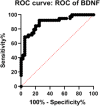Gender influence on clinical manifestations, depressive symptoms and brain-derived neurotrophic factor (BDNF) serum levels in patients affected by fibromyalgia
- PMID: 35344113
- PMCID: PMC9187562
- DOI: 10.1007/s10067-022-06133-y
Gender influence on clinical manifestations, depressive symptoms and brain-derived neurotrophic factor (BDNF) serum levels in patients affected by fibromyalgia
Abstract
Introduction: OBJECTIVES: Fibromyalgia (FM) is a common rheumatic disorder characterized by chronic, widespread pain associated with several not painful symptoms. The contribution of gender to the manifestation of the disease may influence the higher prevalence of FM among women. In spite of this, how patients' gender influences the clinical manifestation of FM is still not well understood. The frequent association with neuropsychiatric symptoms raised the attention on the role of neurotrophins, including the brain-derived neurotrophic factor (BDNF) as potential biomarkers of the condition. Aims of the study were to evaluate the influence of gender on clinical manifestations and to investigate BDNF serum levels as a potential biomarker of FM.
Methods: We consecutively enrolled 201 adult patients of both sexes diagnosed with FM. For each patient, we collected clinical and clinimetric data and, in a subgroup of 40 patients, we measured serum BDNF levels. BDNF levels have been measured also in 40 matched healthy controls (HC).
Results: Several symptoms were significantly higher in women compared with men, including pain, fatigue, memory problems, tenderness, balance problems and sensitivity to environmental stimuli. On the contrary, men reported a significant higher frequency of coexisting depressive symptoms. BDNF levels were significantly lower in FM patients compared with HC, discriminating with good accuracy the condition.
Conclusion: Gender influences FM clinical manifestations, with a higher prevalence of pain, fatigue and other common FM symptoms among women while higher frequency of neuropsychiatric symptoms among men. BDNF offers promises as a potential biomarker of the disease. Key Points • Gender-related differences in the clinical manifestations of FM may contribute to the higher prevalence of FM among females. Indeed, women show higher levels of pain and symptoms traditionally associated to FM, which are evaluated to establish the diagnosis according to the clinical criteria. • The new insights into the pathogenesis of the disease raised the attention on the role of brain mediators in FM. Among these, BNDF shows potential as a diagnostic biomarker.
Keywords: Brain-derived neurotrophic factor (BDNF); Fibromyalgia; Gender.
© 2022. The Author(s).
Figures



Similar articles
-
DNA Methylation and Brain-Derived Neurotrophic Factor Expression Account for Symptoms and Widespread Hyperalgesia in Patients With Chronic Fatigue Syndrome and Comorbid Fibromyalgia.Arthritis Rheumatol. 2020 Nov;72(11):1936-1944. doi: 10.1002/art.41405. Epub 2020 Oct 7. Arthritis Rheumatol. 2020. PMID: 32562379
-
Increased plasma levels of brain derived neurotrophic factor (BDNF) in patients with fibromyalgia.Neurochem Res. 2010 May;35(5):830-4. doi: 10.1007/s11064-010-0129-z. Neurochem Res. 2010. PMID: 20119637
-
Association between brain-derived neurotrophic factor gene polymorphisms and fibromyalgia in a Korean population: a multicenter study.Arthritis Res Ther. 2018 Oct 3;20(1):220. doi: 10.1186/s13075-018-1726-5. Arthritis Res Ther. 2018. PMID: 30285822 Free PMC article.
-
Brain-derived neurotrophic factor in fibromyalgia: A systematic review and meta-analysis of its role as a potential biomarker.PLoS One. 2023 Dec 21;18(12):e0296103. doi: 10.1371/journal.pone.0296103. eCollection 2023. PLoS One. 2023. PMID: 38127937 Free PMC article.
-
Methodological approach to depressive symptoms in fibromyalgia patients.Clin Exp Rheumatol. 2012 Nov-Dec;30(6 Suppl 74):136-42. Epub 2012 Dec 14. Clin Exp Rheumatol. 2012. PMID: 23261013 Review.
Cited by
-
Gender differences in clinical presentations and sensory profiles in patients with fibromyalgia: implications of peripheral and central mechanisms.Pain Rep. 2025 Jan 13;10(1):e1229. doi: 10.1097/PR9.0000000000001229. eCollection 2025 Feb. Pain Rep. 2025. PMID: 39816906 Free PMC article.
-
The Role of the Brain-Derived Neurotrophic Factor in Chronic Pain: Links to Central Sensitization and Neuroinflammation.Biomolecules. 2024 Jan 5;14(1):71. doi: 10.3390/biom14010071. Biomolecules. 2024. PMID: 38254671 Free PMC article. Review.
-
Fibromyalgia Syndrome Pain in Men and Women: A Scoping Review.Healthcare (Basel). 2023 Jan 11;11(2):223. doi: 10.3390/healthcare11020223. Healthcare (Basel). 2023. PMID: 36673591 Free PMC article.
-
Mechanisms of transcranial direct current stimulation (tDCS) for pain in patients with fibromyalgia syndrome.Front Mol Neurosci. 2024 Jan 30;17:1269636. doi: 10.3389/fnmol.2024.1269636. eCollection 2024. Front Mol Neurosci. 2024. PMID: 38356687 Free PMC article. Review.
-
Emotional experiences and gender roles of men with fibromyalgia syndrome: a cross-cultural qualitative study.Front Med (Lausanne). 2024 May 20;11:1286729. doi: 10.3389/fmed.2024.1286729. eCollection 2024. Front Med (Lausanne). 2024. PMID: 38831991 Free PMC article.
References
MeSH terms
Substances
LinkOut - more resources
Full Text Sources
Medical

